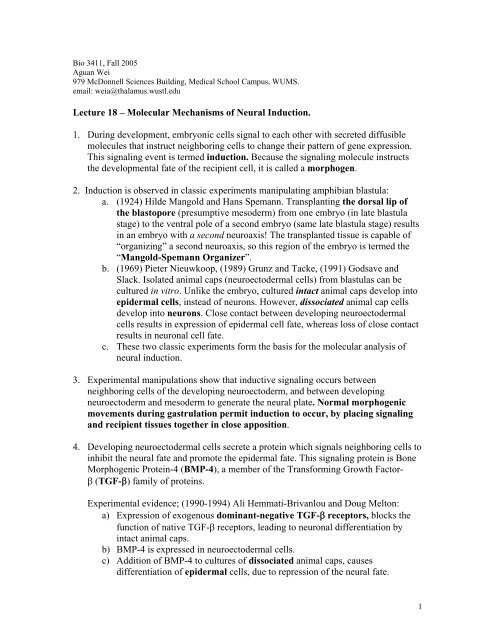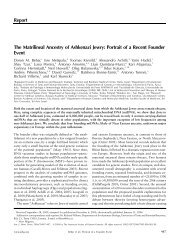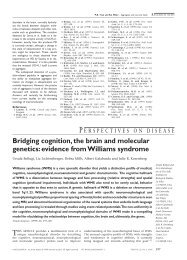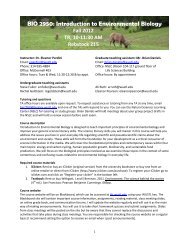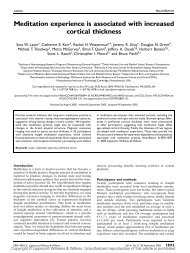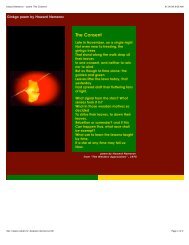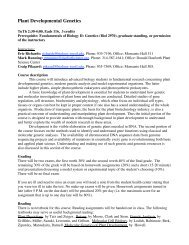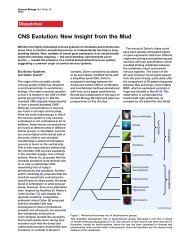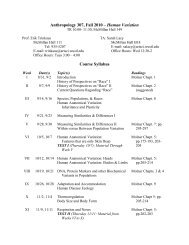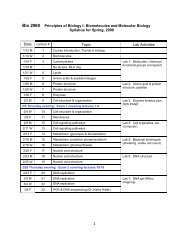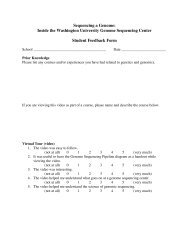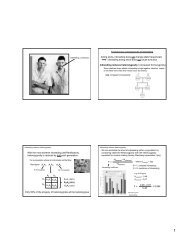Molecular Mechanisms of Neural Induction. 1. During development ...
Molecular Mechanisms of Neural Induction. 1. During development ...
Molecular Mechanisms of Neural Induction. 1. During development ...
You also want an ePaper? Increase the reach of your titles
YUMPU automatically turns print PDFs into web optimized ePapers that Google loves.
Bio 3411, Fall 2005Aguan Wei979 McDonnell Sciences Building, Medical School Campus, WUMS.email: weia@thalamus.wustl.eduLecture 18 – <strong>Molecular</strong> <strong>Mechanisms</strong> <strong>of</strong> <strong>Neural</strong> <strong>Induction</strong>.<strong>1.</strong> <strong>During</strong> <strong>development</strong>, embryonic cells signal to each other with secreted diffusiblemolecules that instruct neighboring cells to change their pattern <strong>of</strong> gene expression.This signaling event is termed induction. Because the signaling molecule instructsthe <strong>development</strong>al fate <strong>of</strong> the recipient cell, it is called a morphogen.2. <strong>Induction</strong> is observed in classic experiments manipulating amphibian blastula:a. (1924) Hilde Mangold and Hans Spemann. Transplanting the dorsal lip <strong>of</strong>the blastopore (presumptive mesoderm) from one embryo (in late blastulastage) to the ventral pole <strong>of</strong> a second embryo (same late blastula stage) resultsin an embryo with a second neuroaxis! The transplanted tissue is capable <strong>of</strong>“organizing” a second neuroaxis, so this region <strong>of</strong> the embryo is termed the“Mangold-Spemann Organizer”.b. (1969) Pieter Nieuwkoop, (1989) Grunz and Tacke, (1991) Godsave andSlack. Isolated animal caps (neuroectodermal cells) from blastulas can becultured in vitro. Unlike the embryo, cultured intact animal caps develop intoepidermal cells, instead <strong>of</strong> neurons. However, dissociated animal cap cellsdevelop into neurons. Close contact between developing neuroectodermalcells results in expression <strong>of</strong> epidermal cell fate, whereas loss <strong>of</strong> close contactresults in neuronal cell fate.c. These two classic experiments form the basis for the molecular analysis <strong>of</strong>neural induction.3. Experimental manipulations show that inductive signaling occurs betweenneighboring cells <strong>of</strong> the developing neuroectoderm, and between developingneuroectoderm and mesoderm to generate the neural plate. Normal morphogenicmovements during gastrulation permit induction to occur, by placing signalingand recipient tissues together in close apposition.4. Developing neuroectodermal cells secrete a protein which signals neighboring cells toinhibit the neural fate and promote the epidermal fate. This signaling protein is BoneMorphogenic Protein-4 (BMP-4), a member <strong>of</strong> the Transforming Growth Factorβ(TGF-β) family <strong>of</strong> proteins.Experimental evidence; (1990-1994) Ali Hemmati-Brivanlou and Doug Melton:a) Expression <strong>of</strong> exogenous dominant-negative TGF-β receptors, blocks thefunction <strong>of</strong> native TGF-β receptors, leading to neuronal differentiation byintact animal caps.b) BMP-4 is expressed in neuroectodermal cells.c) Addition <strong>of</strong> BMP-4 to cultures <strong>of</strong> dissociated animal caps, causesdifferentiation <strong>of</strong> epidermal cells, due to repression <strong>of</strong> the neural fate.1
Neurogenesis: Inductive <strong>Mechanisms</strong> in a Nutshell.<strong>1.</strong> Neuroectodermal cells choose either a neuronal or epidermalcell fate.2. Interactions between mesoderm and neuroectoderm induceneuroectoderm to adopt the neural fate.3. <strong>Induction</strong> acts through signaling by a secreted protein, BoneMorphogenic Protein-4 (BMP-4), made by neuroectodermalcells.4. BMP-4 inhibits neuralization and promotes the epidermal fatein neighboring cells.5. Mesodermal cells secrete proteins (Chordin, Noggin,Follistatin) which directly bind and antagonize BMP-4 activity.6. Neuroectodermal cells become neurons by suppression <strong>of</strong>BMP-4 activity by secreted proteins from underlyingmesodermal cells.7. The “default” state <strong>of</strong> neuroectodermal cells is neuronal.8. This inductive mechanism is conserved between vertebratesand invertebrates.9. BMP-4 is a member <strong>of</strong> the Transforming Growth Factor (TGF-β)family <strong>of</strong> signaling molecules. Similar signaling events maybelocally re-employed later in the developing nervous system.4


